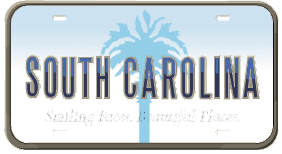| Reason Foundation Mobility ProjectTraffic Congestion in America’s Cities |
|
|||
| How bad will traffic congestion be in 2030? How much construction and how many new lane miles will each state and major city need to add over the next 25 years to prevent severe congestion? And how much will it all cost? The Reason Foundation study Building Roads to Reduce Traffic Congestion in America’s Cities: How Much and at What Cost? and its addendum, A Detailed State-by-State Analysis of Future Congestion and Capacity Needs, provide in-depth answers to these questions. An interactive map ranking the states by congestion and costs to reduce traffic is here and a map of the most congested cities is here. | ||||
| South Carolina | [view other states] | |||
| To significantly reduce today’s severe congestion and prepare for growth expected by 2030, South Carolina needs just over 1,900 new lane-miles at a total cost of $4.9 billion, in today’s dollars. That’s a cost of approximately $97 per resident each year. South Carolina ranks 17th out of 50 states and the District of Columbia in terms of most lane-miles needed and 18th in the total costs of those improvements. If the state made these improvements, it would save over 19 million hours per year that are now wasted in traffic jams.South Carolina has one city that currently suffers from severe congestion, which this study identifies as those areas with Travel Time Indices (TTIs) of 1.18 or higher. The port city of Charleston is the 41st most congested region in the United States, with a TTI of 1.20. This means that driving times during peak traffic are 20 percent longer than during off-peak times.
Unless major steps are taken to relieve congestion, drivers in Charleston can expect to see a TTI of 1.34 by 2030. For an idea of how severe that level of congestion would be, note that this projection is equivalent to the traffic delays experienced today in places like Minneapolis-St. Paul, Boston, and Phoenix. But South Carolina can significantly reduce this congestion problem by adding about 1,900 new lane-miles by 2030 at an estimated cost of $4.9 billion in today’s dollars. This investment would save an estimated 19 million hours per year that are now lost sitting in traffic, at a yearly cost of $10.04 per delay-hour saved. This does not account for the additional benefits not quantified in this study, including: lower fuel use, reduced accident rates and vehicle operating costs, lower shipping costs and truck travel time reductions, greater freight reliability, and a number of benefits associated with greater community accessibility, including an expanded labor pool for employers and new job choices for workers. As Table 47 suggests, the other cities in South Carolina with populations over 50,000 are currently much less congested than Charleston and have TTIs in the 1.04—1.06 range. However, the relative increase in delay projected over the next 25 years for these cities is 100 percent or more, with Myrtle Beach and Columbia facing dramatic increases of 600 percent and 250 percent, respectively. (The ‘delay’ in the travel time is the portion of the TTI over 1.0.) Such significant increases will be sharply felt by local commuters. With TTIs of 1.08, small cities like Anderson and Florence are facing future traffic delays similar to those currently experienced in much larger cities like Dayton, OH and Spokane, WA. » Return to Index Page: Study, State-By-State Data, Maps This information is excerpted from A Detailed State-by-State Analysis of Future Congestion and Capacity Needs and Building Roads to Reduce Traffic Congestion in America’s Cities: How Much and at What Cost? Additional Resources: |



